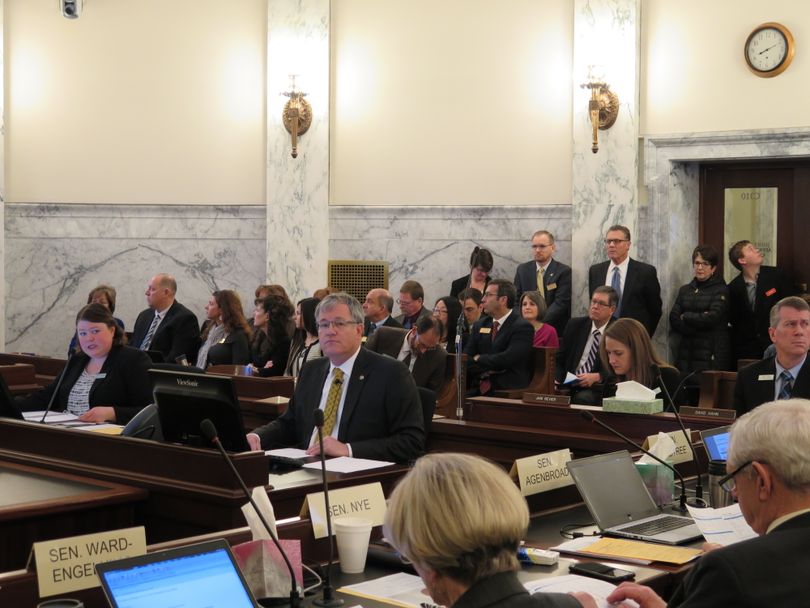Staben talks research, attracting students, tuition at UI and more…

University of Idaho President Chuck Staben told lawmakers today that as UI president, he’s focused on “growing the University of Idaho’s enrollment and on leading a change in Idaho’s college-going culture.” He said he’s seeing some success, in that 6.5 percent more new freshmen enrolled at the University of Idaho this fall. “The direct admissions program that we initiated in partnership with the State Board… appears to be responsible in good measure for the systemwide increase we saw in incoming freshmen this fall,” he said.
Students now get a letter telling them they qualify for admission, before they even apply. Staben shared the story of a student who decided to apply to the U of I based on that letter, and didn’t think it’d be an option for him before that; the student now is thriving in college. A recent survey showed 30 percent of those who received the direct-admissions letters thought it made them more likely or much more likely to attend college.
“This fall the University of Idaho went farther,” Staben said: It waived its admissions processing and application fee. “I believe no student in Idaho should forego college just for the lack of 60 dollars in cash, and we know students for whom that 60 dollars is a barrier,” he said. The U of I also changed its financial aid deadline and processing time, now that parents are allowed to use their previous year’s tax returns to complete the FAFSA. It’s now notifying thousands of students about their financial aid offers before Christmas, allowing them to take that into account when they make their decision about where to enroll.
Staben also highlighted the university’s research, which he said exceeded the $100 million dollar mark in research expenditures this year as ranked by the National Science Foundation. “It is an important gauge of the depth and breadth of research at the U of I,” he said. “We are proud of the results of that work, which you can see in your communities. … Our work makes an impact in economic development and innovation.”
The University of Idaho has three budget requests for next year: Adding the fourth year to the new computer science degree program in Coeur d’Alene, which Gov. Butch Otter recommends fully funding at $715,100; occupancy costs for several new buildings, which mostly are recommended for funding; and a nearly $2 million investment to improve the U of I’s library to achieve Carnegie R1 status, the classification for a major research institution. That proposal, which calls for eight new employees and $1.1 million in capital outlay, would extend library hours to 24 hours and expand offerings and services. “We conduct actually twice as much research as all other Idaho universities combined. So we need much larger library resources,” he said. Otter didn’t recommend funding that request.
Several JFAC members had questions for Staben, ranging from praise for the streamlining of financial aid awards to questions about how much of the university’s funding comes from the state – about 20 percent – and whether tuition might rise next year.
“U of I offers a great education at a cost below the national average. We have minimized tuition increases during my presidency,” Staben said. But he said for every 1 percent CEC, or change in employee compensation, that the state authorizes, the cost to the university necessitates a 1 percent tuition increase. So with the governor’s 3 percent CEC recommendation for next year, which the Legislature has endorsed, he anticipates a 3 percent increase in student tuition next year.
Sen. Jeff Agenbroad, R-Nampa, after asking several questions, added a comment: “Go Vandals.” Agenbroad, like several other JFAC members, is a U of I grad.
The Coeur d’Alene computer science program allows students to complete their first two years at North Idaho College, and then finish their bachelor’s degree at the University of Idaho, all in Coeur d’Alene. The proposal for next year includes two additional faculty positions and converting a part-time administrative position to full-time.
“I believe this program meets a demand for computer science education and technology in the Coeur d’Alene market,” Staben said. There are now 80 students “in the program pipeline,” he said. He called last year’s state investment, which funded the third year for those students, “an excellent building block,” and welcomed the governor’s recommendation to fund the fourth year of the program next year. It also includes capital outlay funding to add a cybersecurity laboratory.
Overall, the U of I’s budget request for next year from all funds is $180.2 million; Otter’s recommendation is $176.8 million. Otter is recommending a 2.2 percent increase in state general funds for higher education, including all of Idaho’s four-year public colleges and universities, next year, 1.2 percent in total funds; the total request was for an 8.8 percent increase in general funds and 4.2 percent overall.
